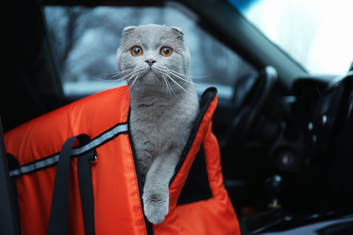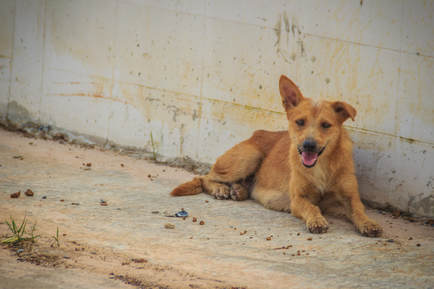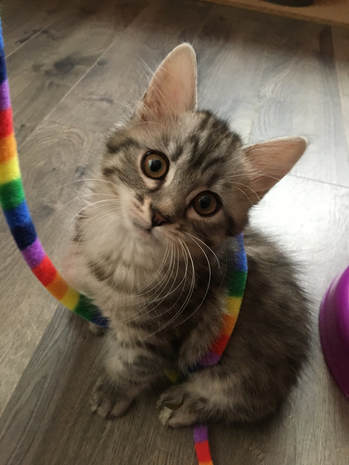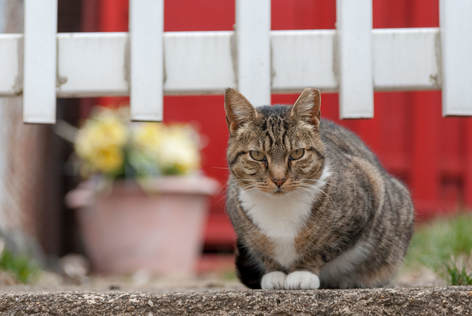 We don’t know about you but Alley Cat Rescue staff is feeling the heat here in Brentwood, Maryland. If people are feeling the effects of the hot weather that means our beloved pets are too. There are plenty of ways to keep your pets safe during the summer (read our summer tips here), but one of the easiest ways is to keep your pets out of hot cars. It might not seem like a big deal to leave your cat or dog in the car while you run a few errands, but a hot car can quickly become fatal to innocent animals. The American Veterinary Medical Association estimates that hundreds of animals die each year from heat exhaustion after being left in hot cars. The temperature in a car can rise almost 20 degrees in just ten minutes. After an hour, the temperature can rise over 40 degrees. This means that even on cooler days the inside of your car could be deadly for animals. Cracking your window will do little to prevent your car from quickly becoming a sauna. A study conducted by the Louisiana Office of Public Health found that cracking the window in a car had minimal effects on the temperature rise. The only way to ensure your pets are safe is to keep them out of unattended cars! Slowly, legislative changes have been made to address this issue. In total, 29 states and the District of Columbia have laws against leaving unattended animals in cars. Not every state that has a law prohibiting leaving animals in cars allows for citizens to rescue the animals. In fact, in New Jersey and West Virginia it is illegal to leave an animal in the car and it is illegal to break into a car to save the animal, even for law enforcement. Only 13 states (Arizona, California, Colorado, Florida, Kansas, Louisiana, Indiana, Massachusetts, Ohio, Oregon, Tennessee, Vermont and Wisconsin) have “Good Samaritan” laws that allow private citizens to rescue animals from cars themselves. If you live in these states be careful before you rescue an animal. Some of the laws outline certain steps you need to take before breaking a window, such as contacting law enforcement, so you can be exempt from criminal liability. Never leave your own companion animals alone in a vehicle, and make sure you are familiar with the laws in your state so that you know how to act if you see an unattended animal in distress. When in doubt, call your local law enforcement and alert them of the situation. Meetings can be rescheduled, errands run at a different time, and broken windows can be fixed, but there’s no replacing a cherished member of the family.
1 Comment
 It seems every time an international sporting event is coming up there are news stories about plans to cull stray animals in host cities and countries. Most recently, Russia has been in the news over concerns that the country killed stray dogs ahead of the soccer World Cup. Although Deputy Prime Minister Vitaly Mutko has said that the country built shelters to hold the stray dogs, there are still concerns about the fate of these dogs. It is estimated that 2 million stray dogs live in the cities hosting the World Cup. Simply putting these dogs in shelters during the World Cup is not a viable solution. If these shelters become overcrowded then it is likely that some of the dogs will be euthanized. Russia may also be trying to hide their stray dog issue without actually addressing stray dog overpopulation. Culling stray dogs is a short-sighted and ineffective solution. Countries that implement eradication plans ahead of international sporting events are more concerned with appearances than the welfare of the animals. Additionally, the eradication plans can quickly become expensive. One of the cities that is hosting the World Cup paid a company $560,000 in January to catch and hold stray dogs. While government officials state that holding the dogs is humane, Russian activists say that the dogs are being held for just 10 days and then euthanized. Ahead of the 2014 Olympics, the Russian city of Sochi paid a company $29,000 to kill 1,200 stray dogs and cats with poisoned darts. Alley Cat Rescue and other animal groups advocate for the use of humane sterilization plans to manage animal populations. Many countries currently implement sterilization plans for stray dogs that are similar to the trap-neuter-return (TNR) method Alley Cat Rescue uses for community cats. Under these programs, stray dogs are given a rabies vaccine and sterilized. Just like in TNR, friendly dogs can be adopted out and unsocialized dogs are returned back outside. These programs help address the public health and appearance concerns that countries may have ahead of international events. Russia and other host countries should reject eradication plans and instead allocate funds for long-term sterilization programs. Concerned animal lovers should boycott international events where stray animals are killed and demand that humane solutions are used instead.  After Hurricane Harvey hit last autumn, thousands of pets were thought to be displaced or missing. The aftermath was devastating to many people and homes, but also animals living in the area. Now, with the recent floodings in Maryland and hurricane season underway, there’s no doubt that many pet guardians are wondering about the safety of their animal companions. In the past, victims have been told to leave their pets behind. Most Red Cross shelters do not accept pets, and at the time of Hurricane Katrina, there were no federal or state laws addressing the safety of pets when planning for disasters. Though victims of Hurricane Katrina were told that they could not bring their dogs and cats with them to shelters, a poll from the Fritz Institute found that 44% of the people who refused to evacuate did so because they wanted to remain with their pets. In response to the aftermath of Katrina, the Pets Evacuation and Transportation Standards (PETS) Act was born. It requires that response plans “account for the needs of individuals with household pets and service animals before, during and following a major disaster or emergency.” If staying behind is too dangerous for you, then it’s too dangerous for your pets! Here are some ways for pet guardians to prepare for a disaster:
 A recent New York Times article came out about the feral cats that Google employees are feeding at their corporate headquarters, called Googleplex. Instead of focusing on the good work these employees are doing, the article discussed criticism Google is receiving from bird groups. According to the article, bird groups blame the feral cats Google staff are trap-neuter-returning for the population declines of the burrowing owl. While Alley Cat Rescue cares deeply about bird populations, the connections between the feral cats and the owls are minimal at best. The article states one instance of an owl being found dead after being followed by a cat, and one photo of a cat with a bird in its mouth as evidence that the cats are causing the population declines. Instead of grasping at straws, we should focus on the true causes of the burrowing owl’s population declines. According to both the Urban Bird Foundation and California Audubon Society, loss of habitat is a central cause of the burrowing owl’s population declines. In fact, a golf course next to the Googleplex has caused multiple owls to die. The article states, “One of the biggest threats uses the Shoreline golf course. A bleak Mountain View report three months ago noted there have been deaths ‘due to direct contact between golf balls and burrowing owls.’” Alley Cat Rescue has reached out to Google to ask them to keep implementing their trap-neuter-return program and we ask you to do the same! Trap-neuter-return will help to manage the feral cat population and will reduce problem behaviors such as roaming, keeping the owls and cats apart. Further, if eradication methods were used against the cats around the Googleplex, these methods could kill the burrowing owls as well. You can contact Google here: 1600 Amphitheatre Parkway Mountain View, CA 94043 USA 1-877-355-5787 |
Details
AuthorAlley Cat Rescue is leading in the way in promoting humane and compassionate care for ALL cats. Archives
June 2024
Categories
All
|
 RSS Feed
RSS Feed